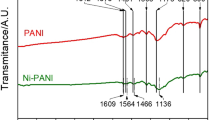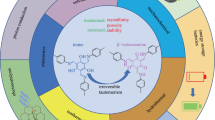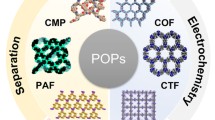Abstract
A series of dodecylbenzene sulphonic acid (DBSA) doped poly(aniline-co-m-aminoacetophenone) copolymer composites of different compositions were synthesized in micellar solution of DBSA to obtain nanosphere morphology with enhanced processability. The plausible mechanism for the formation of poly(aniline-co-m-aminoacetophenone)-DBSA copolymer composite has been presented. These DBSA doped copolymer composites were characterized by UV–Visible, FTIR spectroscopy and XRD analysis techniques. UV–Vis absorption spectrum of the composites showed 325 and 637 nm which corresponds to the π–π* and n–π* transition. In FTIR spectroscopy a broad band around 2,924 cm−1 corresponds to C–H vibration of DBSA indicating good agreement with the characteristic bands of DBSA. The sharp band at 1,292 cm−1 is assigned to C–N stretching mode of vibration of N–Ph–N units. The X-ray diffraction of composites reveals that these composites are amorphous in nature. The number of diffraction peaks decreased with increase in the m-aminoacetophenone content. It indicates that these composites are amorphous in nature. Morphological studies (SEM) reveal that these composites have a spherical morphology with the average size of 100–200 nm. These composites exhibit electrical conductivity value of 0.744 × 10−3 S/cm and enhanced solubility than polyaniline. Moreover, at the presented work, the DBSA doped copolymer composites were obtained in high yields by keeping an oxidant to co-monomer ratio of 1:1.





Similar content being viewed by others
References
Wan M (2009) Some issues related to polyaniline micro-/nanostructures. Macromol Rapid Commun 30:963–975
Hung CC, Wen TC, Wei Y (2010) Site-selective deposition of ultra-fine Au nanoparticles on polyaniline nanofibers for H2O2 sensing. Mater Chem Phys 122:392–396
Li D, Huang J, Kaner RB (2009) Polyaniline nanofibers: a unique polymer nanostructure for versatile applications. Acc Chem Res 42:135–145
Wu CG, Bein T (1994) Conducting polyaniline filaments in a mesoporous channel host. Science 264:1757–1759
Yang J, Burkinshaw SM, Zhou J, Monkman AP, Brown PJ (2003) Fabrication and characteristics of 2-acrylamido-2-methyl-1-propanesulfonic acid-doped polyaniline hollow fibers. Adv Mater 15:1081–1084
Virji S, Huang J, Kaner RB, Weiller BH (2004) Polyaniline nanofiber gas sensors: examination of response mechanisms. Nano Lett 4:491–496
Huang J, Virji S, Weiller BH, Kaner RB (2003) Polyaniline nanofibers: facile synthesis and chemical sensors. J Am Chem Soc 125:314–315
Reddy KR, Lee KP, Lee Y, Gopalan AI (2008) Facile synthesis of conducting polymer-metal hybrid nanocomposite by in situ chemical oxidative polymerization with negatively charged metal nanoparticles. Mater Lett 62:1815–1818
Han MG, Cho SK, Oh SG, Im SS (2002) Preparation and characterization of polyaniline nanoparticles synthesized from DBSA micellar solution. Synthetic Met 126:53–60
Rao PS, Sathyanarayana DN (2003) Synthesis of electrically conducting copolymers of o-/m-toluidines and o-/m-amino benzoic acid in an organic peroxide system and their characterization. Synthetic Met 138:519–527
Arsalani N, Khavei M, Entezami AA (2003) Synthesis and characterization of novel N-substituted polyaniline by Triton X-100. Iran Polym J 12:237–242
Massoumi B, Badalkhani O, Gheybi H, Entezami AA (2011) Poly(N-octadecylaniline) synthesis and its electrochemical parametric characterizations. Iran Polym J 20:779–793
Savitha P, Rao PS, Sathyanarayana DN (2005) Highly conductive new aniline copolymers: poly (aniline-co-aminoacetophenone)s. Polym Int 54:1243–1250
Martin CR (1995) Template synthesis of electronically conductive polymer nanostructures. Acc Chem Res 28:61–68
Zhang X, Manohar SK (2004) Polyaniline nanofibers: chemical synthesis using surfactants. Chem Commun 20:2360–2361
Yan Y, Yu Z, Huang YW, Yuan WX, Wei ZX (2007) Helical polyaniline nanofibers induced by chiral dopants by a polymerization process. Adv Mater 19:3353–3357
Huang L, Wang Z, Wang H, Cheng X, Mitra A, Yan Y (2002) Polyaniline nanowires by electropolymerization from liquid crystalline phases. J Mater Chem 12:388–391
Niu Z, Liu J, Lee LA, Bruckman MA, Zhao D, Koley G, Wang Q (2007) Biological templated synthesis of water-soluble conductive polymeric nanowires. Nano Lett 7:3729–3733
Huang J, Kaner RB (2004) A general chemical route to polyaniline nanofibers. J Am Chem Soc 126:851–855
Chiou NR, Epstein AJ (2005) Polyaniline nanofibers prepared by dilute polymerization. Adv Mater 17:1679–1683
Li W, Wang HL (2004) Oligomer-assisted synthesis of chiral polyaniline nanofibers. J Am Chem Soc 126:2278–2279
Yin H, Yang J (2011) Synthesis of high-performance one-dimensional polyaniline nanostructures using dodecylbenzene sulfonic acid as soft template. Mater Lett 65:850–853
Österholm JE, Cao Y, Klavetter F, Smith P (1993) Emulsion polymerization of aniline. Synthetic Met 55:1034–1039
Babazadeh M (2007) A direct one-pot method for synthesis of polyaniline doped with dodecyl benzene sulphonic acid in aqueous medium and study of its thermal properties. Iran Polym J 16:389–396
Stejskala J, Omastova M, Fedorova S, Prokes J, Trchova M (2003) Polyaniline and polypyrrole prepared in the presence of surfactants: a comparative conductivity study. Polymer 44:1353–1358
Ragupathy D, Gomathi P, Lee SC, Al-Deyab SS, Lee SH, Ghim HD (2012) One-step synthesis of electrically conductive polyaniline nanostructures by oxidative polymerization method. J Ind Eng Chem 18:1213–1215
Ding S, Mao H, Zhang W (2008) Fabrication of DBSA-doped polyaniline nanorods by interfacial polymerization. J Appl Polym Sci 109:2842–2847
Lei X, Su Z (2007) Novel conducting polyaniline copolymers of aniline and N-phenylglycine. Mater Lett 61:1158–1161
Ebrahim SM, Gad A, Morsy A (2010) Highly crystalline and soluble dodecylbenzene sulfonic acid doped poly (o-toluidine). Synthetic Met 160:2658–2663
Babazadeh M (2009) Aqueous dispersions of DBSA-doped polyaniline: one-pot preparation, characterization, and properties study. J Appl Polym Sci 113:3980–3984
Savitha P, Sathyanarayana DN (2004) Copolymers of aniline with o- and m-toluidine: synthesis and characterization. Polym Int 53:106–112
Acknowledgments
The authors gratefully acknowledged the Council of Scientific Industrial Research (CSIR) for the financial support and the Management of Bannari Amman Institute of Technology for providing necessary facilities to carry out the Research.
Author information
Authors and Affiliations
Corresponding author
Rights and permissions
About this article
Cite this article
Ravi Kumar, G., Vivekanandan, J., Mahudeswaran, A. et al. Synthesis and characterization of novel poly(aniline-co-m-aminoacetophenone) copolymer nanocomposites using dodecylbenzene sulfonic acid as a soft template. Iran Polym J 22, 923–929 (2013). https://doi.org/10.1007/s13726-013-0191-x
Received:
Accepted:
Published:
Issue Date:
DOI: https://doi.org/10.1007/s13726-013-0191-x




